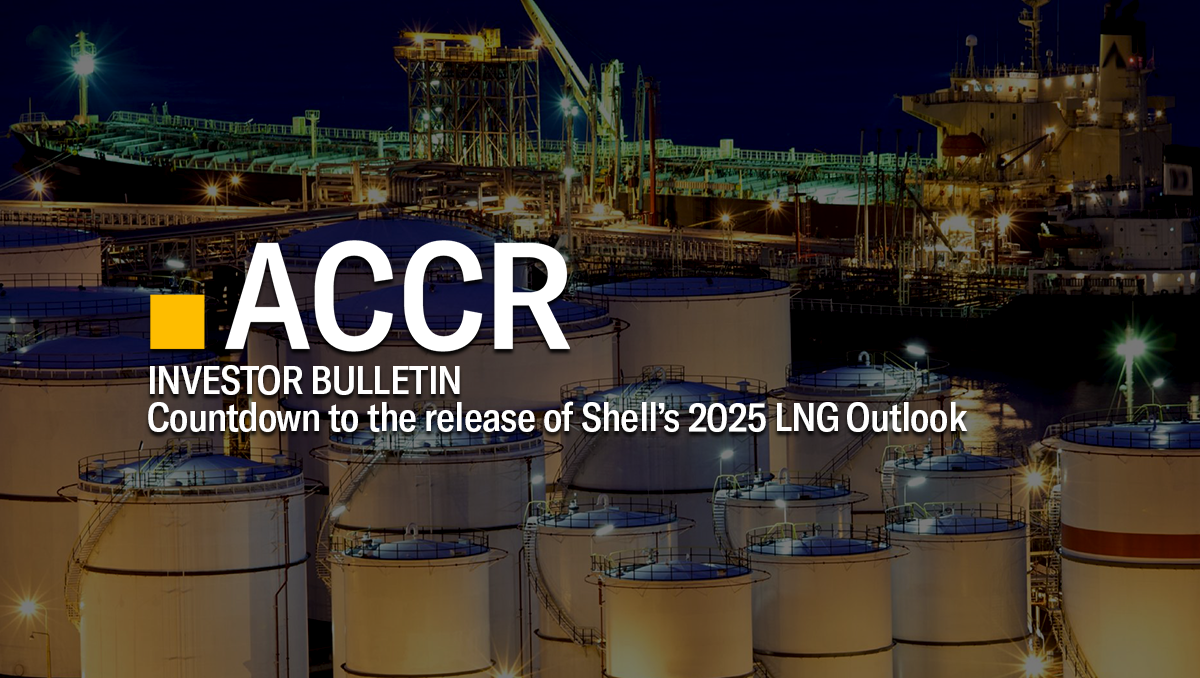Investor Insight Investor Bulletin: Countdown to the release of Shell’s 2025 LNG Outlook
Shell’s 2025 LNG Outlook is set to be released next week, coming as the company faces growing scrutiny from investors – including a shareholder resolution - around the assumptions used by the company to underpin its liquefied natural gas (LNG) growth strategy.
Shell expects to grow its LNG business 20-30% by 2030, with LNG projected to account for nearly one-third of the company’s upstream hydrocarbon production by the end of the decade.
Our research shows that Shell’s previous LNG Outlook was a shaky foundation for this growth strategy, with a bullish outlook for future LNG demand which exceeded all of the International Energy Agency’s (IEA) global LNG forecasts.
Further, ACCR and institutional investors - including Brunel Pension Partnership, Greater Manchester Pension Fund and Merseyside Pension Fund - have filed a shareholder resolution with Shell, asking it to justify the assumptions behind its LNG growth strategy and explain how this is consistent with its climate commitments.
While we will thoroughly review the 2025 LNG Outlook and release our full analysis in March, ahead of its release, we have identified three key areas where Shell can provide greater clarity for investors.
1. Financial risk exposure
As outlined in our research, “Shell’s LNG strategy: Overcooked?”, Shell has bet on a future where LNG plays a major role in the energy mix, particularly emerging markets, exposing shareholders to a range of financial risks:
- Shell has built an unprecedented long LNG position relative to peers. Its production profile and existing contract portfolio leaves it with over one billion tonnes of uncontracted LNG between now and 2050, leaving it heavily exposed should LNG demand, and hence price, fail to meet its expectations.
- Should prices fall, we estimate that the value of Shell’s LNG assets drop by $13 billion with each $1/MMBtu reduction in gas price.
- Shell’s exposure to spot LNG prices is increasing rapidly, because while its production and long-term purchases are projected to increase by 50% to 2035, most of its long-term sales contracts also expire by 2035.
- Even if Shell signs contracts to shift the risk from gas spot prices to other pricing indices, a pricing risk remains, meaning that Shell may not access favourable terms in an LNG supply glut.
- Under all IEA price predictions, Shell’s USA LNG tolling contracts - 22% of its portfolio - would erode shareholder value.
Key stewardship considerations for investors
- Can investors treat Shell’s Outlook as wholly objective, considering Shell has more LNG to sell than any other independent oil and gas company?
- How will the company protect long-term value if prices fall when the imminent LNG supply wave comes online?
- How does Shell expect LNG to compete with the cost of coal and renewables in price-sensitive markets while also delivering attractive prices for Shell’s uncontracted portfolio?
2. Soundness of demand predictions in LNG Outlook
- Shell’s LNG forecast has remained unresponsive to dramatic changes in the global energy market over the past four years. Shell’s outlook has not materially changed since 2020, despite massive declines in the price of renewables and batteries, and unprecedented short-term spikes in LNG prices causing medium- and long-term demand destruction.
- Shell’s LNG Outlook 2024 appears to misinterpret the IEA’s scenarios in a way that makes its outlook appear closer to a 1.5°C scenario than it is. Shell’s interpretation suggests LNG demand will be about 100% higher in 2040 than the actual IEA data projects.
- The LNG Outlook 2024 also overstates the role of gas in China’s industrial transition by mislabelling independent research on Chinese steel decarbonisation.
- Shell underestimates competition from renewables, which are already outcompeting gas power in some emerging markets. According to Bloomberg NEF, the cost of building new solar photovoltaic (PV) will be half that of operating existing gas generators by 2030.
Key stewardship considerations for investors
- Does the apparent misrepresentation of data in the 2024 LNG Outlook damage Shell’s credibility as a reliable commentator?
- Why has the company been so muted when responding to changes in energy markets that have led to demand destruction (such as the accelerated deployment of renewables, or the tainted reputation of LNG as an affordable and/or reliable fuel in South-East Asia)?
- Why does Shell’s forecast differ from those put out by the IEA so significantly? Can these changes be explained by the company?
3. Consistency between LNG growth strategy and climate commitments
Shell’s forecast LNG demand is higher than every IEA scenario. Shell expects demand to be:
- 301% higher than the NZE scenario
- 92% higher than the APS
- 19% higher than the STEPS – a scenario which results in 2.4°C of warming.
Shell is targeting growth ranges of 20-30% for its LNG business and 25-30% for its LNG liquefaction capacity by 2030, despite LNG’s relatively high lifecycle emissions and an imminent supply glut.
Key stewardship considerations for investors
- What are the lifecycle emissions related to the LNG portfolio from 2025 to 2050? How is Shell planning on reducing these emissions through to 2050?
- With the company ‘retiring’ its 2035 target and providing little clarity on its strategy from 2030 to 2050, how will Shell ensure strategic consistency with the goals of the Paris Agreement?
- Does the company consider LNG to be a low-carbon fuel? What evidence does Shell have that LNG is not crowding out faster renewable deployment?
Please read the terms and conditions attached to the use of this site.
